There’s nothing especially magic about living well: The steps we need to take are logical and pretty well-known. But that doesn’t mean a health overhaul comes easy. Too often, despite our best intentions, the pounds pile on. Muscles turn to Jell-O. Stress rules the roost, and sleep is a fitful exercise in tossing and turning and checking the smartphone at 3 a.m.
It doesn’t have to be this way. The difference between failure and success boils down to approach and mindset, to selecting the right habits to tweak and -- crucially -- using the latest science to kick out bad habits and forge better, long-lasting new ones.
Most important of all: This isn’t a temporary fix. It’s a new -- and far more rewarding -- way of living. Read on if you’re ready to get started.
The ways your Fitbit will — and won’t — improve your health
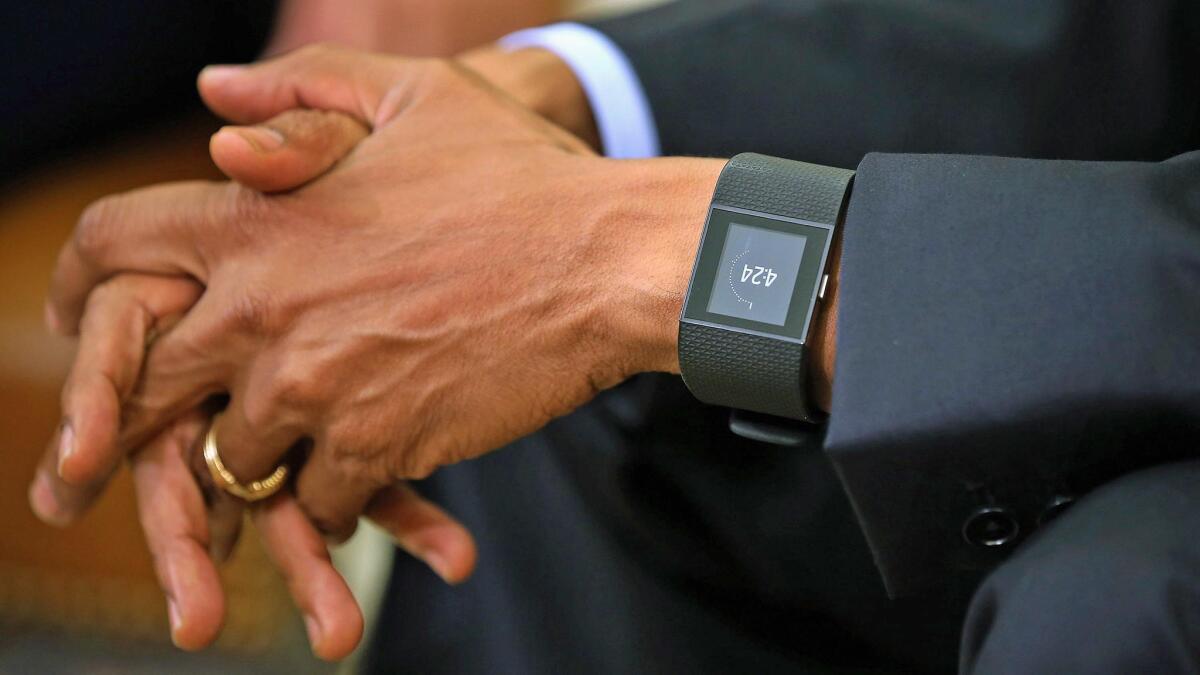
But I believe that one day, your average daily step count will be a core vital sign, like pulse and blood pressure and weight.
— Dr. Raj Khandwalla
Fitbits and other fitness trackers are sneakily addictive. They can give a sense of achievement on the most ordinary day, and they deliver more data about our daily activities than ever before.
But do these gadgets make us healthier? We talked with experts about the ways they might help us reach our wellness goals.
Steps
The default goal is 10,000 steps per day. Dr. Raj Khandwalla, a cardiologist at the Cedars Sinai Heart Institute in Los Angeles, uses the Apple HealthKit to track his exercise progress — and once he started, he stopped using elevators and started using stairs.
“Right now, we still need clinical trials to understand what all this data means. But I think these devices are excellent,” Khandwalla says.
“For the first time, we can quantify activity,” he says. “This can have significant implications for preventing heart disease. It may be as simple as walking 10,000 steps can reduce the risk of having a heart attack in the future. We don’t know. But I believe that one day, your average daily step count will be a core vital sign, like pulse and blood pressure and weight.”
Sleep
So your Fitbit says you slept six hours, woke up twice during the night and were restless 16 times. Fascinating. But is it useful?
Khandwalla believes that with more research, this information will turn out to be valuable. “Improving sleep and sleep quality are more difficult than getting people to exercise more,” he says.
Dr. Michelle Grotz-Rhone, an internist for One Medical Group in Beverly Hills, says the sleep data can give her information that serves as a springboard for discussion, but “I am more concerned about what my patients feel like clinically than what the gadget says.”
Water intake/food diary/calorie count
Perhaps, says Grotz-Rhone, these devices will make people mindful of ways to increase energy, drink enough water and stay away from foods that will cause their blood sugar to spike and then crash. “If someone finds that the gentle reminders throughout the day from a Fitbit works for them, that can promote habit change,” she says.
Dr. Gregory Taylor II, medical director of Keck Medicine of USC in downtown Los Angeles, will give a free fitness tracker to any of the 7,000 faculty and staff at Keck Medical Center who request them because he believes it will improve their health.
If he could get patients to track just one thing, he says, it would be diet. Sleep, diet and exercise are all important, but “if you cannot feed your body the proper ingredients, it cannot perform.”
Friends
Whether you sign up to share your data with friends or simply trash talk with office mates at the water cooler, challenging friends can be motivating, experts say.
“One of the great features of these trackers is that you can compete with others,” says Santiago Prada, a certified personal trainer and director of membership and healthy lifestyles at the Hollywood YMCA. “You can see who burned the most calories, who took the most steps. Everyone is competitive, so sharing with friends ups everybody’s game.”
The larger question is whether these devices promote long-term behavior change. “I think our work shows that gadgets are just gadgets — not magic, except for a few very motivated people,” said Donna Spruijt-Metz, director of the USC mHealth Collaboratory at the university’s Center for Economic and Social Research. “However, I think that a good theory-based intervention that includes mobile health and just-in-time feedback has a much better chance of making a difference.”
Not all stress is created equal. Here’s how you can sort them out
You can’t avoid stress, but you can prepare. Dr. Bruce Rabin, medical director of the Healthy Lifestyle Program at the University of Pittsburgh Medical Center, offered these tips.
Chronic stress: How you cope depends a lot on how you go about your everyday life. Take time for meaningful reflection. Look on the bright side. Have a sense of humor, including about yourself. Socialize with people you like. And don’t just sit there — move.
Acute stress: That sudden, sink-or-swim kind of stress calls for special measures. Rabin recommended three: deep breathing, finding something to laugh about, and chanting to yourself.
You have to ready these coping tools in advance so you can draw on them in the heat of the moment, when acute stress strikes. Sometime when you’re feeling calm, take time to practice deep breathing, memorize a list of things you find funny or compose a chant you find relaxing.
Trying to lose weight? The key is to diet for the long term
On any given day, just over 1 in 5 American adults are actively trying to lose weight. An additional 50% have tried dieting for some length of time, but have retreated to old routines while mounting the will to try again.
Results will be mixed, ensuring the nation’s sprawling diet industry a steady flow of revenue. According to Marketdata Enterprises, which tracks the weight-loss industry, we spend more than $60 billion a year on diet foods, books, coaching, meetings, mobile apps and meal plans to help with weight loss.
Though dieters may be deadly serious in their objectives, roughly 4 in 5 shun expert guidance in favor of a “do-it-yourself” approach, according to Marketdata. These homemade strategies are based on diet plans touted by celebrities or trumpeted in bookstores, online or on TV.
Fads come and go. Confusion reigns. And failure is common.
Physicians generally aren’t much help. Under the Affordable Care Act, whose future is uncertain, primary care doctors are expected to advise all obese patients to lose weight and counsel them on how to do so. Research tells us a doctor’s recommendation can be a powerful spur to weight loss. But few are equipped to lead patients to the specific plan that will work best for them.
It doesn’t help that the science of what works is filled with gaps and contradictions, or that the diet plan that works for one person may not work well for another.
It’s simple to say that to lose weight, calories out must exceed calories in — and that to reverse obesity, just continue the process. But experts say that losing weight, and maintaining that loss, is vastly more complex.
It’s a matter of evolution — adaptations to famine and drought have helped design the human body to abhor the loss of weight. As researchers demonstrated in a study of people who lost about 14% of their starting weight with a very-low-calorie diet, the body undergoes a host of changes to ensure that the weight is regained.
Metabolic rate drops, allowing the post-diet body to do more with fewer calories. Myriad hormonal signals shift in ways that boost appetite. Those changes endure for at least a year after weight is lost, the researchers found. Even after weight comes back, many of those changes persist, ensuring further weight gain.
These findings, which have been replicated by other studies, help explain why 95% of dieters will regain all the weight they lost within five years, and most will gain a few extra pounds as well.
Results like that have fueled a growing expert consensus that “dieting” — temporary adherence to a regimen of eating that causes weight loss — is a fool’s errand. When weight must be lost, experts say, it should be with strategies and eating patterns that can be maintained over the long haul.
Those strategies should be flexible enough to withstand the plateaus of weight loss. They should be sustainable enough to support long-term health and nutrition while helping prevent Type 2 diabetes and other diseases linked to obesity. And they should be tolerable enough to stick with through a “weight loss maintenance” period that may last a lifetime.
In short, diets must become a way of life, not a painful interlude, says Dr. Louis J. Aronne, a weight-loss specialist at Weill Cornell Medical College in New York City who has developed an online program called BMIQ to guide physicians and obese patients on their choices.
“The diet that people find easiest to comply with is the one that works best for them,” Aronne says.
Feeling stressed? Try these proven methods for chilling out
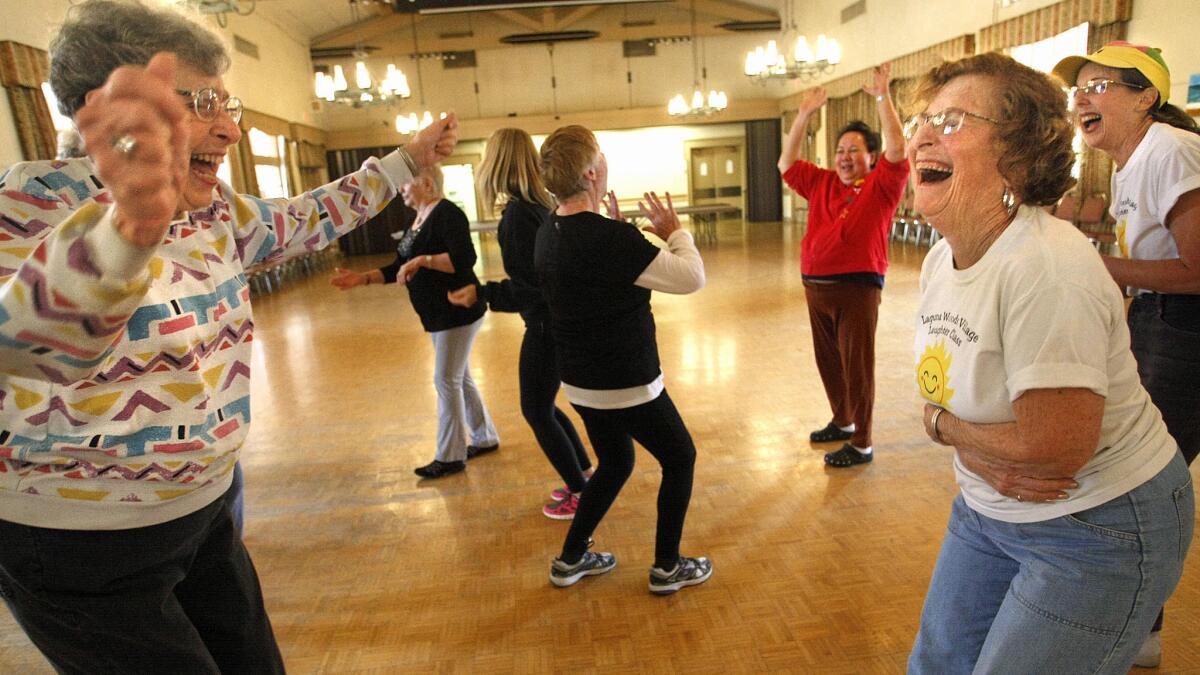
Your boss is yelling at you. Your credit card was just stolen. You’re running late, and you can’t find your car keys.
Stress happens.
And when it does, it triggers the body’s “fight or flight” response. Powerful hormones — such as adrenaline and cortisol — course through your bloodstream. They make your heart pound and your breathing go into overdrive.
This response evolved millenniums ago when the stresses people faced often involved threats to their physical well-being and required literal fight-or-flight decisions: Do battle with a saber-tooth cat or run like mad?
These days, many stresses are chronic, involving long-term problems such as unfulfilling work, a shrinking bank account or an aging loved one. As you stew, your body releases those same powerful hormones. This, experts say, makes chronic stress more than mentally unpleasant — it makes it a health concern.
Chronic stress correlates with many physical ailments, from colds to cancer, said Dr. Emanuel Maidenberg, a clinical professor of psychiatry and biobehavioral sciences at UCLA. “It’s thought to reduce the effectiveness of your immune system, so you’re more likely to become ill in whatever area you’re vulnerable,” he said.
You can learn to manage stress. You can develop a set of tools for bringing the level down. That can’t happen overnight though. You have to practice.
— Dr. Emanuel Maidenberg, UCLA clinical professor of psychiatry and biobehavioral sciences
It also increases inflammation in the body, said Dr. Helen Lavretsky, a geriatric psychiatrist at UCLA, and can lead to cognitive and memory problems, as well as insomnia, anxiety and depression.
So, what to do?
Brain science offers some clues. Dr. Bruce Rabin, medical director of the Healthy Lifestyle Program at the University of Pittsburgh Medical Center, noted that increased oxygen flow to the brain calms down regions that tend to get activated by stress and cause those stress-hormone levels to rise. This suggests that you can reduce the effects of stress by increasing your intake of oxygen, he said.
One good way to do that, of course, is by exercising. Less obvious, perhaps, but also proved: You take in more oxygen when you laugh.
Meditation and yoga are also useful for some people, Lavretsky said, while music and dance can help others.
Don’t expect instant results.
“You can learn to manage stress,” Maidenberg said. “You can develop a set of tools for bringing the level down. That can’t happen overnight though. You have to practice.”
Which diet plan is best for you? Here are the pros and cons of 4 popular options
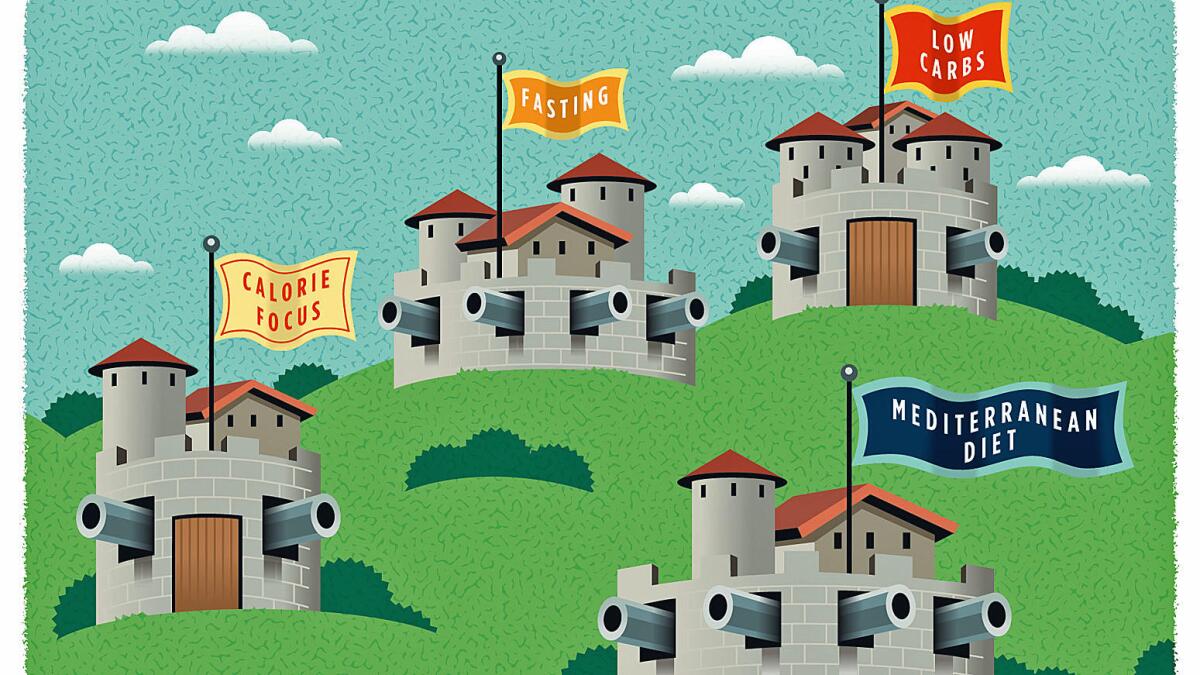
There’s more than one way to eat your way to weight loss. Here are four approaches most often recommended by experts:
Calorie-focused diets
It’s generally the first principle of dieting for weight loss: take in fewer calories. But some diets overtly stress this.
We’ve seen many variants over the years. A recent, popular example is Volumetrics, which focuses on foods with low calorie density — such as fruits, vegetables and broth-based soups — and eating them to fullness.
Low-fat diets got their start as a means of lowering calories, since high-fat foods tend to be calorie-dense. But if fats are replaced with carbs, calorie intake can rise, as many low-fat dieters discovered in the 1980s and 1990s.
Weight Watchers has evolved over the years and found different ways to count calories and fat, but it’s never strayed far from this tried-and-true approach. Mobile apps have made it easier than ever to keep track, and successful calorie-focused dieters tend to be counters, measurers and trackers.
Low-carbohydrate diets
Dr. Robert C. Atkins proposed in the 1970s that dramatically driving down carbs and replacing them largely with high-protein foods would cause bodies to switch into fat-burning mode. That would prompt weight loss and body composition changes that favored lean muscle over fat.
Many variations followed: the Zone Diet, paleo diet, Sugar Busters and the South Beach diet all draw on the idea that cutting carbs is key. An emphasis on protein and a tolerance of fats keeps many dieters from feeling hungry. And the clear identification of foods to avoid — including anything with added sugars — makes low-carb diets easier for those who don’t want to count, don’t want to feel hungry, and don’t mind skipping sugary or carb-rich foods.
These diets also tend to be good for people with, or at risk for, diabetes, since they help keep blood sugar in check.
Intermittent fasting
There’s nothing new to the idea that periodic fasting can lead to renewal; it’s been central to many forms of religious observance for millennia.
But researchers are finding growing evidence that the body can be “tricked” to burn more calories — and fat — by eating foods at certain times of the day or by giving the digestive system a near-total break for a couple days each week. The Fast Diet, big in the U.K., and the Warrior Diet are examples of this new-old approach.
Scientists have turned up evidence in mice that limiting eating and drinking — except for water — to a 12-to-16-hour period during mainly daylight hours could correct a metabolism overwhelmed by 24/7 eating and aid in weight management. Now the idea is being tested in humans. It may not help people working graveyard shifts, or those who fear the sensation of hunger. But for dieters who would rather skimp on when they eat than what or how much, it might be just the thing.
Mediterranean diet
This really did start as a way of life. For eons, peoples living along the Mediterranean mostly ate foods that came from plants and the sea. Fresh fruits and vegetables, legumes and nuts were the backbone, often drenched in olive oil. Fish was a near-daily staple, washed down by a glass or so of red wine. Grains were whole, dairy and poultry were used sparingly, and red meat and sweets were almost absent.
Research quickly established that these eaters had low rates of cardiovascular or metabolic disease. A landmark 2013 clinical trial confirmed that for people in middle age or older, following elements of a Mediterranean diet drove down heart attacks and strokes in those with diabetes, obesity or other risk factors.
Though its principles could easily be adapted to weight loss, the Mediterranean diet isn’t designed for this. But it is powerful at protecting and enhancing health, and may mitigate some of the effects of extra weight. Given the difficulties of reversing established obesity, this way of eating is a no-brainer.
Why the benefits of sleep go far beyond beauty
If you slept more, would you be more likely to remember your mom’s birthday? To inhale fewer bagels? To turn down a deal for the Brooklyn Bridge? Very possibly.
Research shows that when you don’t get enough sleep, you forget things you otherwise wouldn’t, develop cravings for simple carbohydrates, and tend to make dumb decisions.
Your brain uses sleep time to catch up on important chores, says Dr. Alon Avidan, professor of neurology and director of the UCLA Sleep Disorders Center. These include organizing memories, making repairs, and clearing out the mess that has accumulated during the day, including harmful neurotoxins.
“Without enough sleep, your brain can’t go through this cleaning process,” Avidan says.
Some 50 to 70 million adults in the United States have problems sleeping, according to the Centers for Disease Control and Prevention. And getting too few zzzz’s can spell all kinds of trouble. Science has linked chronic sleep loss to any number of health issues, including heart disease, high blood pressure, diabetes, depression and anxiety. Though statistics are hard to come by, experts believe that driving when you’re too tired is as dangerous as driving when you’ve had too much to drink.
Avidan says most adults need seven or eight hours of sleep every night. “Very few can do well with less,” he explains, “and some need even more.”
He also warns that it’s not easy to make up for lost time. If you consistently get too little sleep during the week, your debt adds up. You can’t hope to settle accounts just by doing better on the weekend.
Alas, there’s a lack of foolproof techniques for falling asleep when you want to, but many find the following tips useful. They’re from Avidan, the National Sleep Foundation and Dr. Suzanne Stevens, a sleep neurologist at the University of Kansas Hospital in Kansas City:
• Stick to a schedule. Always go to bed at the same time and get up at the same time.
• Be sure your bedroom is quiet, dark and has a comfortable temperature.
• Don’t nap too much, and never late in the day or for too long.
• Avoid exercise within three hours of bedtime.
• Avoid caffeine after 1 or 2 pm.
• Avoid alcohol within one or two hours of bedtime.
• Don’t watch TV or work on the computer close to bedtime.
• Don’t bring your phone or laptop to bed.
• Don’t eat too much too late, though snacking on such sleep-promoters as turkey, milk, granola, banana or tart cherry juice may be useful.
• Take a warm bath before bedtime.
It’s counterproductive to try to fall asleep when you’re feeling wide awake or obsessed with stressful thoughts. Get up, move to a different room, and try to bore yourself with a dull book. Only when you start feeling drowsy should you go back to bed.
As Avidan tells his patients, “Bed should only be used for sleep, sickness and sex.”
‘Weight creep’ is a normal part of aging, but if you’re on guard you can reduce your risk
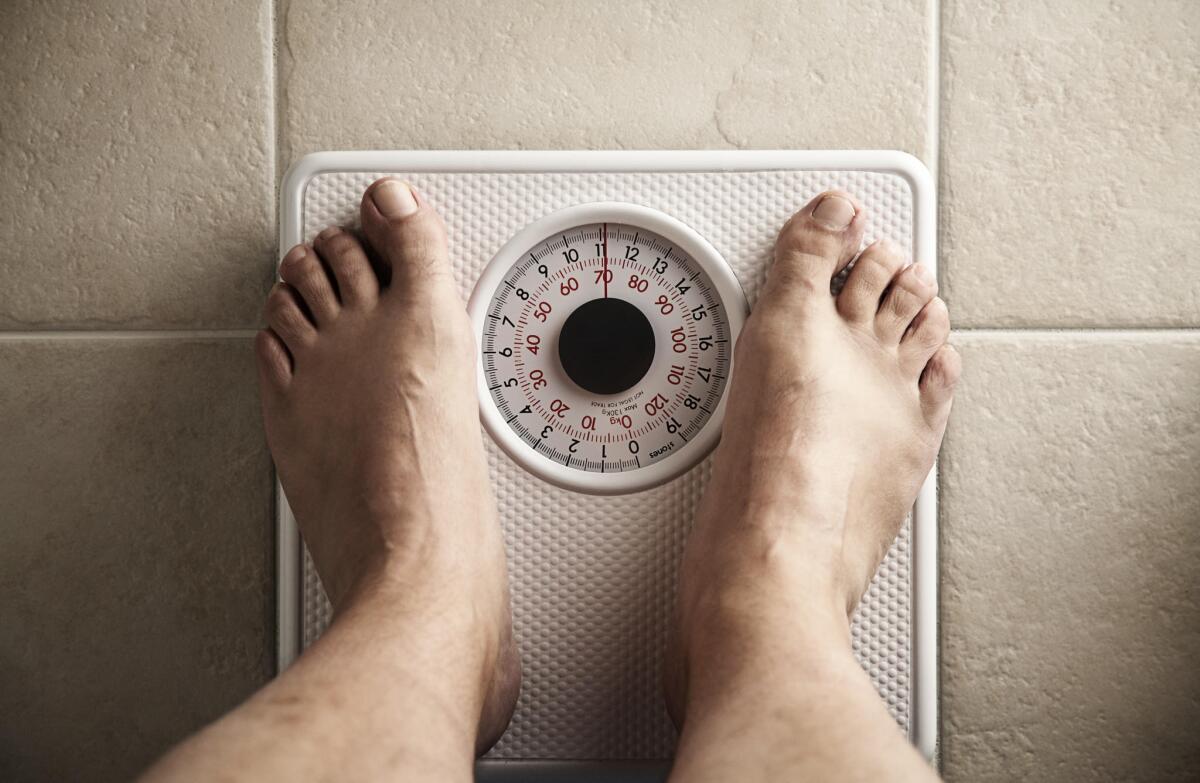
Many unwelcome changes stalk us as we age, but “weight creep” is among the most insidious. A 2011 study of 120,877 Americans found that people as young as their mid-30s begin to gain close to one pound per year, on average, with women slightly outpacing men.
To make matters worse, more of the weight we carry as we get older is fat and less of it is muscle. In men and women alike, cellular and hormonal changes that start at midlife promote a steady loss of muscle mass called sarcopenia. And in women nearing menopause, declining estrogen levels allow more fat to be stored in the belly and waist.
As muscle gives way to fat, the aging body burns fewer calories. And our thermostats also get turned down, because stores of “brown fat” — a form of fat that intensively burns calories to create heat when we’re young — diminish with the passing years.
The problem is that even as our metabolisms downshift, few of us respond by paring our calorie intake (appetites don’t naturally decline at midlife) or boosting our calorie expenditures through exercise. As energy levels flag, we strain to carry around the extra pounds we’ve picked up. The recliner starts to look a lot more inviting than a cardio machine.
At a certain point, obesity appears to garble the hormonal signals that travel among the brain, gut and muscles and tell us to eat when we’re hungry and stop when we’re satisfied, said Dr. Louis J. Aronne, an endocrinologist and obesity expert at Weill Cornell Medical College in New York City. As these checks on appetite fail, weight gain can be hard to stop — or reverse.
This upward spiral is not universal, Aronne said: In Japan, for instance, people seem to change their consumption patterns around midlife, halting the process by which fat begets more fat.
“If you never damage that signaling to begin with, you never start the upward cycle,” Aronne said.
What we eat matters. That 2011 study also found that as people aged, those who regularly ate potatoes in any form, consumed processed foods and routinely sipped sugary drinks or alcohol gained the most weight with age. So did those who watched the most television.
Sleep mattered too: Those who slept fewer than six hours a night, or more than eight, were more likely to gain steadily.
But the situation isn’t hopeless. The difference between holding steady and gaining nearly a pound a year is 50 to 100 calories a day. A brisk walk, or a decision to forgo one small dietary indulgence, could make all the difference.
When it comes to eating right, focus on the things that matter and don’t sweat the other stuff
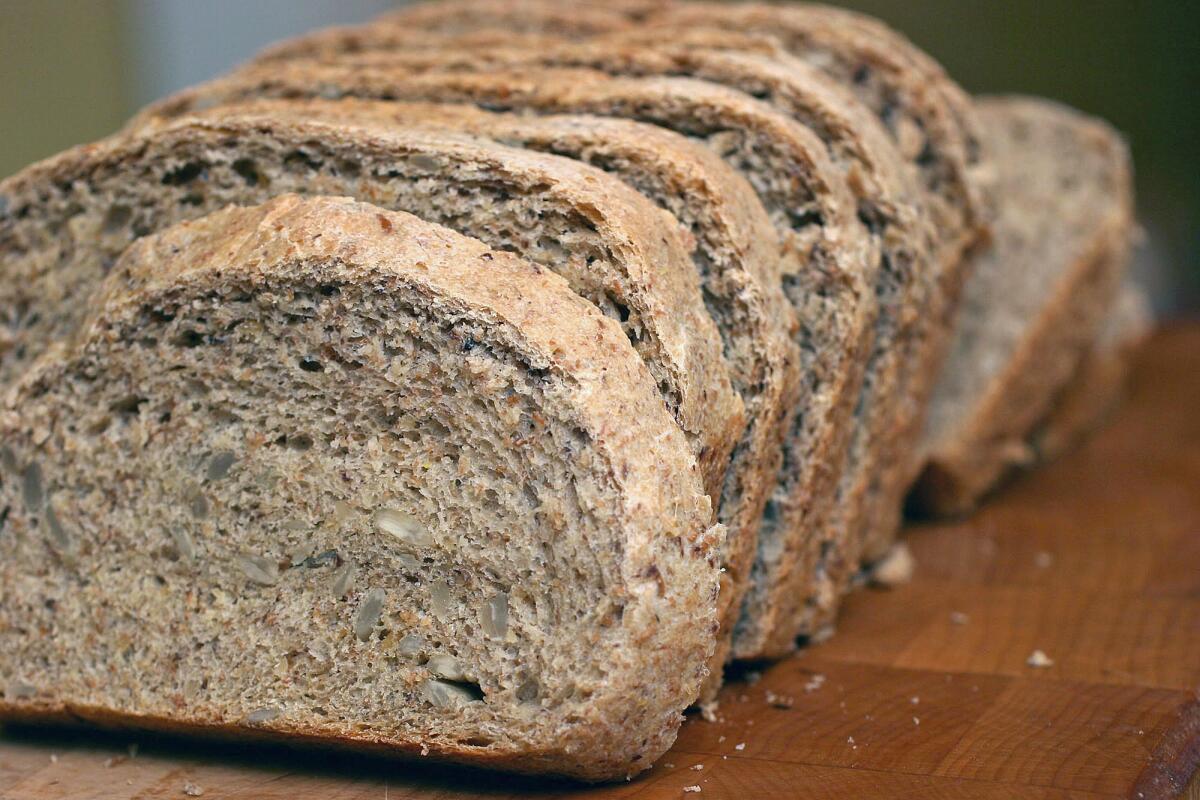
In this time of organic, gluten-free, non-GMO flaxseed muffins, it’s easy to feel overwhelmed by food choices. We have more options than ever — and more chances to wonder if we’re really eating right. Some choices matter, but other things aren’t nearly as important as they may seem. When building a healthy diet, it helps to know: What things should you sweat over, and which just aren’t worth the worry?
Sweat it
Fiber: Sure, a diet high in fiber — the indigestible roughage from fruits, vegetables and grains — will help keep you regular. But that’s just a bonus. Dietary fiber protects the heart: A 2013 study in the journal BMJ estimated that each 7 grams of fiber a day cut the risk of heart disease by about 10%. Importantly, fiber also creates feelings of fullness, making it easier to stick to a reasonable diet.
“After calories and portion sizes, fiber is the main thing that I tell my clients to watch out for,” said Marina Chaparro, a dietician in Miami and a spokesperson for the Academy of Nutrition and Dietetics. She said she encourages clients to read labels when buying bread, cereals and other grain-based products. If there’s 3 or more grams of fiber per serving, it’s likely a winner.
Note that “soluble” fiber (found in produce and oats) and “insoluble” fiber (found in wheat and other grains as well as produce) are good for heart and health. Fiber supplements can be helpful too, but they don’t pack the nutritional punch of high-fiber foods.
Sugar: Twenty teaspoons of added sugar sounds like the makings of a decadent cake, but it’s actually the amount the average American eats each day. The American Heart Assn. recommends cutting back to just 6 teaspoons (24 grams) of added sugar for women and 9 teaspoons (36 grams) for men. The latest government guidelines, from 2015, suggest about 12 teaspoons (50 grams) for anyone on a typical 2,000 calorie diet.
There’s good reason to watch sugar: Too much raises the risk of diabetes, heart disease and obesity. Because sugar often lurks in sodas, fancy coffees, sports drinks and juices, Chaparro said she urges clients to drink water — the original sugar-free beverage. (And, by the way, she said that “natural” sugars such as honey and agave syrup aren’t better for you than the white stuff.)
Oils: These fall into two categories: heart-friendly and heart-not-so-friendly. The best oils — including canola, safflower, peanut, olive and mixed vegetable oils — are packed with polyunsaturated or monounsaturated fats that, according to the American Heart Assn., can help lower cholesterol and prevent heart disease. Polyunsaturated fats also seem to ward off diabetes by increasing sensitivity to insulin, said Martha Belury, professor of human nutrition at Ohio State University. “There’s definitely a place for healthy oils in a good diet,” she said
Belury recommends avoiding cooking with tropical oils such as palm oil and coconut oil — these have more saturated fat, which in large amounts can lead to clogged arteries. And one more thing: Belury and other nutrition experts recommend that we increase our intake of oils rich in omega-3 fatty acids, which help protect the brain as well as the heart. Good sources are fatty, cold-water fish as well as nuts and seeds.
Don’t sweat it
Gluten: Lots of people shun gluten — a protein found in wheat, barley and some other grains — for no good reason, Chaparro said. Unless you’re one of the rare people with celiac disease or a sensitivity to gluten, the protein can be a no-sweat part of a healthy diet, she said. “It frustrates me to see healthy people avoiding gluten when they don’t need to.”
She notes that gluten-free diets can lack some of the fiber and vitamins found in whole-grain foods. “There’s a perception that gluten is a villain,” she said. “But the lack of gluten in a food doesn’t tell you anything about its nutrition.”
Organic: In general, there’s no health reason to seek out that organic sticker at the grocery store, Belury said. Studies find that non-organic foods are just as tasty and nutritious. Belury recommends picking foods that look fresh and giving them a good wash — after all, even organic foods can have pesticide residue that you don’t necessarily want in your meals.
The organic label may matter with milk, though. A 2016 study in the British Journal of Nutrition reported that organic milk contained about 50% more omega-3 fatty acids than did non-organic milk. Organic milk also had slightly more vitamin E and iron.
Multivitamins: Despite millions of dollars’ worth of studies, there’s no good evidence that multivitamins have anything to offer the average, healthy person. They don’t seem to protect against any disease, they don’t boost energy and they don’t help people live longer.
“Unless you have a really poor diet, you can spend your money on something else,” Chaparro said. Still, she added, multivitamins can be a good insurance policy for vegetarians and other people who have large dietary gaps.
Muscle mass declines with age. Here’s what you can do about it
Many people despair to see the number on the scale creep up as they grow older. But they don’t realize that as they’re gaining weight, they’re losing something too: muscle.
A small amount of muscle loss is nearly inevitable with age. While the rate varies quite a bit, studies suggest the average person loses about 1% of muscle every year after about age 50, says Dr. Elena Volpi, director of the Sealy Center on Aging at the University of Texas Medical Branch in Galveston.
The causes are complex. Lower levels of testosterone and estrogen in older people mean the body maintains less muscle. A person’s genes influence how much they’re likely to lose. Getting sick or injured, and particularly spending time in the hospital, can shrink muscles. So can inflammatory conditions such as arthritis.
Plus, yo-yo diets will always cause people to lose at least a bit of muscle, and they tend to regain those pounds in the form of fat.
Laziness is a big cause of muscle loss. “You don’t use it, you lose it,” says Miriam Nelson, director of the Sustainability Institute at the University of New Hampshire in Durham and author of the bestselling book “Strong Women Stay Young.”
That’s bad news, not just because it makes it harder to lift a heavy suitcase or wriggling grandchild. Muscle helps burn calories, and it acts as a storage depot for crucial proteins that help you recover from injury or illness.
Still, there’s hope. “Even into your 90s, you can regain muscle mass,” Nelson says.
Exercise is the way to go — specifically resistance exercises such as weight training, two or three times a week. Free weights and exercises that make you heft your own body weight, such as squats and sit-ups, can do the job. In studies, Nelson and her colleagues have found that resistance training like this improved strength, balance and muscle mass in older women.
To avoid injury — particularly for those who are out of shape or have other health problems — Volpi and Nelson recommend supervision. That can mean using a personal trainer or joining a program at a YMCA or senior center.
Getting enough protein is key to maintaining or building muscle. In the Health ABC Study, a large study of older adults, those who kept their muscle were the ones who ate the most protein. Most people get plenty through their diets; Volpi recommends 20 to 30 grams at each meal (that’s something like a small burger or a few eggs). It’s best to spread that protein intake across your three daily meals rather than having it all at dinner, she adds.
If you’re getting that, protein supplements like powders or shakes won’t help, Nelson says. But supplements might be an option for people who don’t eat enough protein. It might also help those who are ill or recovering from disease, Volpi says.
Testosterone injections might help maintain muscle in men with low levels of this hormone, she adds.
Out of shape? You can probably blame bad habits. But it’s never too late to build better ones
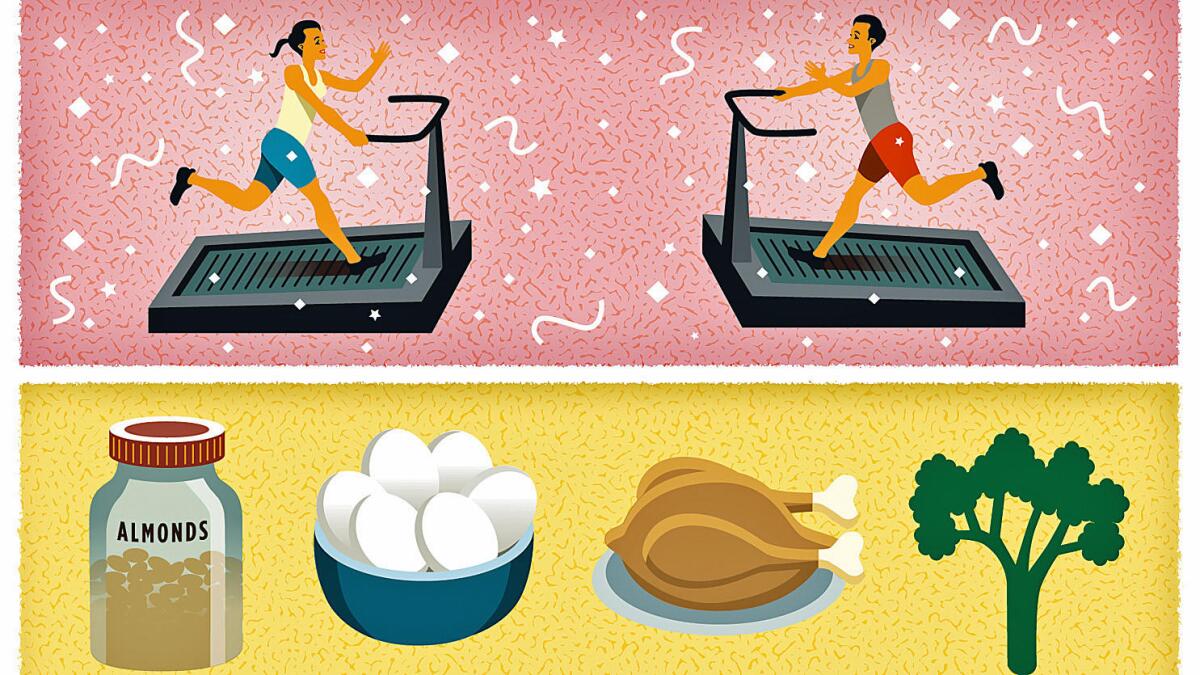
Tomorrow is a new day, but you probably know a lot about it already: what you’ll have for breakfast, the route you’ll take to your office, which website you’ll visit first. None of us has the mental energy to think about everything we do, so we spend a lot of time on autopilot, following patterns over and over.
In short, life is habit-forming.
But some habits are healthier than others. If you’re looking to feel better, fitter and generally happier, you’ll likely have to uproot some old routines and set the stage for something new. It’s not as impossible as it sounds. With the right approach, you can create good habits that are just as effortless as bad ones, says Wendy Wood, a psychologist at USC.
Habits take practice. If you do something over and over — be it your morning coffee run, your evening Netflix ritual or your nightly refrigerator raids — the act can become automatic, and you keep doing it even if you no longer enjoy it.
“Habits are shortcuts to what worked in the past,” Wood says.
As Wood explains in the Annual Review of Psychology, habits are built through a loop of triggers, rewards and repetition. Each loop follows its own circuit in the brain. In other words, your brain is literally wired to fall into habits.
Pick something that you can picture yourself doing for the long term. Something that makes you feel proud.
— Alison Phillips, exercise psychologist
One way to break the pattern is to avoid the triggers that set habits in motion, Wood says. If you still feel like you’re stuck, she recommends telling yourself: “Don’t do it.” It’s a message that brings mindfulness to a usually mindless activity.
You should also examine the “rewards” your habits give you — they may not be as rewarding as you assume. Does that nightly dessert really make you happy, or has it just become a thing you do? In his book “The Power of Habit,” author Charles Duhigg recommends experimenting with new routines to see if there are other ways to feel rewarded.
You can then use the power of repetition to build new, healthier routines, says Alison Phillips, an exercise psychologist at Iowa State University in Ames. To forge an exercise habit, Phillips recommends doing an activity regularly for at least a month.
“If you repeat it enough, you can learn to like it,” she says.
But there does need to be at least some appeal from the start. “If you have to force yourself to do it, and if you’re never going to like it, it won’t become a habit,” she says. “Pick something that you can picture yourself doing for the long term. Something that makes you feel proud.”
Consistency is key. As Wood explains, people who try to get in shape by dabbling in lots of different activities generally don’t make a habit of working out. “People who successfully lose weight and keep it off tend to have an exercise routine where they are doing the same thing again and again,” she says.
To really get a handle on habits, Wood says you also need to pay attention to the triggers that set off automatic responses. For some, the mere sight of a drive-through can set off a chain reaction that ends with empty wrappers and regret.
But Wood adds that triggers can also be helpful. A bowl of fruit on the kitchen table can practically guarantee a healthy snacking habit. And if you exercise after work, simply shutting off your computer for the day can put you in a workout frame of mind.
Be aware: Bad habits can return, especially when you feel stressed, pressed for time or distracted. In such circumstances, it’s easy to fall back on old routines that don’t require thought or effort. But if you stay vigilant, Wood says, you can catch yourself and change your ways before you get stuck in old ruts.
In the end, living the way you want is the best habit of all.
Seven things you can do right now to put yourself on a path to better health

You’d like to live a healthier life. But that goal is so big that you don’t know where to start.
If you’re feeling overwhelmed, here are seven simple ways to launch your personal health makeover.
Floss
Yes, you should. Many of us were surprised to learn last year that flossing lacked clear benefits in medical studies. But we should keep up the habit anyway, according to the American Dental Assn. and the Centers for Disease Control and Prevention.
Studies have been few, small and potentially flawed by people who claim they floss more, and more thoroughly, than they really do, experts say. But the signs of non-flossing — red, puffy gums and unwanted “pockets” between gums and teeth — are obvious to dentists, says Dr. Alexandre-Amir Aalam, clinical assistant professor at USC’s Herman Ostrow School of Dentistry.
Brushing can’t get between teeth to remove “bad” bacteria. Flossing gets at least four times deeper into gums than brushing does. Technique matters, so ask your dentist for tips at your next visit. And don’t forget your regular, professional teeth-cleanings.
Keep an eye on your eyes
Many people — perhaps even you — assume nothing is wrong with their eyes if nothing seems to be. But “silent” conditions can do damage before symptoms show up, says Dr. Rohit Varma, director of the USC Roski Eye Institute and dean of the Keck School of Medicine at USC.
A comprehensive eye exam can find them early. Regular exams are most important for babies and kids (to check for congenital problems and nearsightedness) and people over 50 (for age-related problems such as cataracts, glaucoma and macular degeneration).
But younger adults aren’t immune — farsightedness starts about age 40 — and the National Institute of Occupational Safety and Health suggests yearly exams for computer users of any age. Computer-related problems (most commonly dry eye) are so widespread there’s a name for them: computer vision syndrome.
Step it up
Does the journey to better health begin with 10,000 steps? It might.
Being active burns calories, builds muscle and boosts your energy and mood. And counting your steps is a good way to keep track of how active you are, says Dr. Neha Vyas, a family medicine physician at the Cleveland Clinic. Many experts believe that 10,000 steps a day — about 5 miles — is a good number for most people to aim for. But, she adds, “The reality is that any amount of activity is beneficial.”
Be skeptical
You can learn a lot about health on the Internet. Some of it is even true. But how can you tell facts from malarkey?
You can generally trust information from local, state, and county health departments, academic institutions, the Centers for Disease Control and Prevention, and medical associations such as American Academy of Family Physicians and Infectious Diseases Society of America.
You should beware of rosy health claims for dietary supplements. These products are not vetted by the Food and Drug Administration the way medicines are, so regulators can’t vouch for their safety or effectiveness. Supplement manufacturers aren’t free to knowingly make false marketing claims. Still, sometimes they may assert things that have not been subject to rigorous, objective testing.
Think fun!
A rose by any other name might smell as sweet. But call exercise by another name and it might do you more good, a pair of experiments suggest.
In one, 46 adults went for a 2-kilometer walk around a lake. Half were told it was an “exercise walk” and half were told it was a “scenic walk.” When it came time for a mid-afternoon snack, the “exercise” walkers ate more than twice as many M&Ms as the “scenic” walkers — a difference that amounted to 206 additional calories. In the other, the “exercise” group ate 35% more chocolate pudding at lunch.
The key is to think of activity as fun, says Brian Wansink, director of the Cornell University Food and Brand Lab and one of the researchers involved in the experiments. If you tell yourself you’re working out, you’re likely to reward yourself by eating more. “So tell yourself it’s personal time,” Wansink says. “Say, ‘I’m doing this for me.’”
Feed your tiny friends
You may not realize it, but you’re eating for millions — of microbes. In fact, scientists estimate that at least half the cells in your body aren’t actually human at all.
You’re the big kahuna for your microbes, says Dr. Zhaoping Li, director at UCLA’s Center for Human Nutrition. You control their destiny. Which brings us to fiber. Scientists used to believe fiber was only good for avoiding constipation. But now they know you need it to keep your microbes happy. Eat plenty of the best kinds — the ones in fruits, vegetables and whole grains — if you want your microbes to maintain an orderly society. That, in turn, can help you maintain a healthy body.
Make protein a priority
Your body needs sugar, fat and protein to carry out its daily metabolic chores. And it’s very good — sometimes too good — at keeping stores of sugar and fat accessible. But protein? Not so much.
“Your protein pool can only last 3 to 4 hours,” Li says. That means three meals a day are not optional — they’re vital. And each meal should include about 20 grams of protein, roughly the weight of eight pennies.
If you skip a meal, your body will make do by breaking down your skeletal muscle to get the amino acids it requires. In general, once you replenish your protein pool, your body will return the amino acids it borrowed from your muscles, so no permanent damage is done. But if you deprive it of protein too often, it may not be able to repay the big debt you rack up.
And be extra careful if you’re getting older: Your body just isn’t as good then at paying back what it owes, and you may never be able to restore the muscle you’ve lost.
Exercise won’t necessarily help you lose weight, but it will help you keep it off
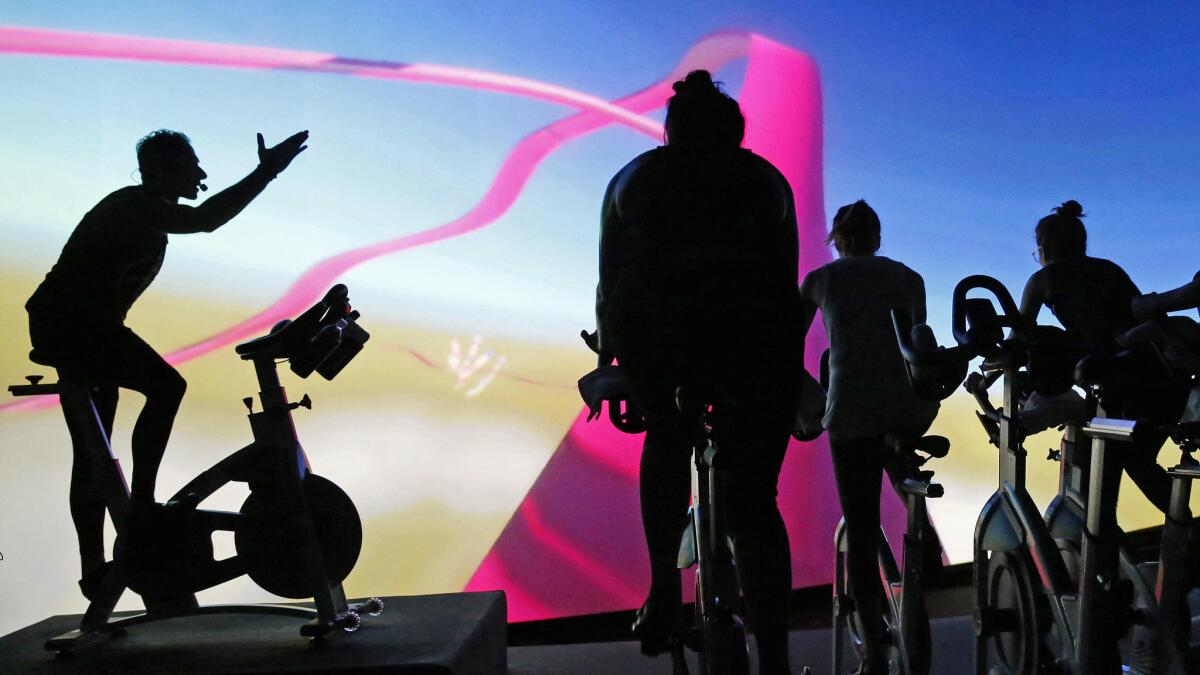
Hoping to shimmy into those skinny jeans by adding an extra spin class to your workout routine or spending more time on the treadmill?
Sorry, say experts, you’re out of luck. Exercise, while enormously beneficial for maintaining a healthy weight, doesn’t tend to be effective for shedding pounds. The best way to trim the flab is to minimize the food on your plate.
“You cannot outrun a bad diet,” as an editorial in the British Journal of Sports Medicine put it.
“Yes, exercise would work if you did enough of it — it’s just so much easier to eat less,” says James Hill, professor of pediatrics and medicine at the University of Colorado Anschutz Medical Campus in Aurora. It takes mere seconds to scarf a 200-calorie candy bar, but 40 minutes of walking to burn that off. And with weight loss, you’re not just trying to break even — you’re aiming for a calorie deficit.
Taking the stairs does not earn you a cheeseburger.
Some people — about 15% of us — may even find that exercise makes them much hungrier, countering weight loss goals, says Dr. Tim Church, a professor of preventive medicine at the Pennington Biomedical Research Center in Baton Rouge, La.
But exercise does play a key role: It helps keep weight off once you’ve lost it. Since 1994, Hill has tracked more than 10,000 people in the National Weight Control Registry who shed an average of 66 pounds each and kept it off for more than five years. “Only 9% of them maintain their weight without significant exercise — so it’s possible, but it’s very rare,” Hill says.
For one thing, it’s hard to cut food calories over the long term. Exercise, on the other hand, burns added calories. It also improves metabolism, including how the body manages blood sugar and appetite. You’re giving yourself a “safety margin” for those days when you eat a bit too much.
But don’t overestimate that margin, Church warns. Taking the stairs does not earn you a cheeseburger.
In addition to keeping you trim, exercise is good for the heart, the liver and other essential organs, studies show. It even helps the brain by alleviating depression and anxiety, and by warding off cognitive decline later in life.
“You name it, exercise helps it,” Church says.
Hill says those who’ve lost a lot of weight and don’t want to regain it should exercise for 70 minutes a day. (People who were never obese can get away with less— yes, life is unfair.) That could include planned workouts like going to the gym, but also casual activities like walking around a mall or playing Pokemon Go.
“Figure out what works for you,” Church says.
Try these tricks to stop your mindless eating
Most of us are such creatures of habit that we often eat without thinking — it doesn’t take much brain power to pick up a fork. Instead of pondering choices or listening to our bodies, we mindlessly follow cues from the outside world that tell us when and what to eat.
You can’t turn every bite into an intellectual exercise, but you can nudge yourself in the right direction by tweaking your environment and basic approach to food. Brian Wansink, director of the Cornell University Food and Brand Lab in Ithaca, N.Y., suggested these food fixes:
• Use smaller bowls and plates. You’ll naturally end up with smaller portions.
• When loading up a plate, cover half of it with vegetables.
• Put healthier, lower-calorie foods in the front of fridge where they are easier to reach. The cheese can go in the back.
• Get rid of the cookie jar. Replace it with a fruit bowl.
• When putting away leftovers, wrap the most tempting items in foil so they’re easier to put out of mind.
• Instead of eating straight from a package, transfer food to a plate or bowl so you can see the portion size.
• If you stockpile foods, put them out of sight until you really need them.